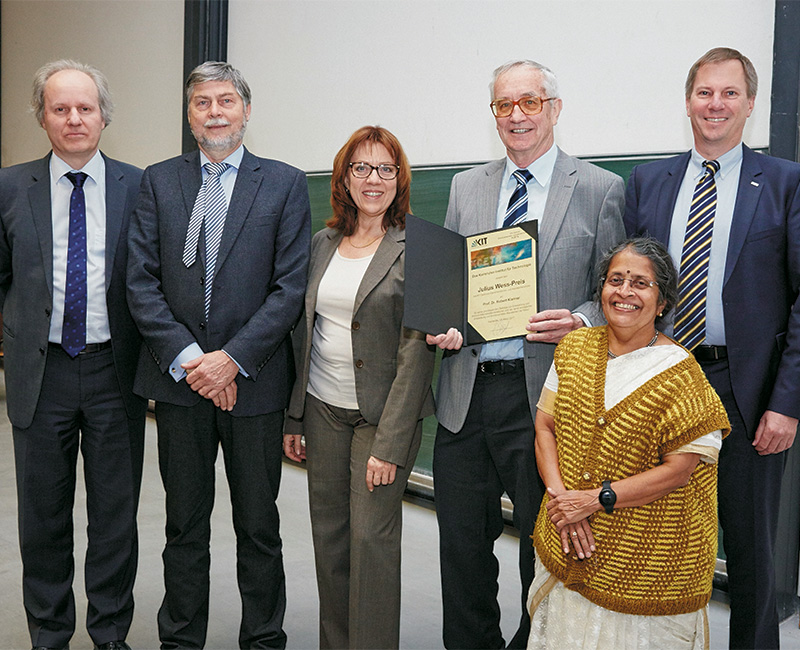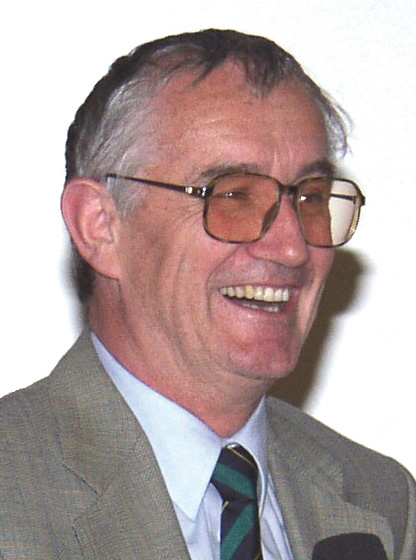Julius Wess Award 2016
The presentation of the award took place on March 3rd, 2017. In a festive event Prof. Klanner received the award from Prof. Oliver Kraft (Vice President for Research, KIT), accompanied by a very appreciated talk by Prof. Rohini Godbole from the Indian Institute of Science, Bangelore ("Higgs-Boson and the Physics beyond the Standard Model"), an introduction to the KIT Center KCETA by Prof. Marc Weber (Scientific Spokesperson of KCETA) and the laudatio by Prof. Thomas Müller (KIT). After the presentation of the award Prof. Klanner gave a highly esteemed talk on "Silicon Detectors: From the early days to the LHC and XFEL". The Ensemble Claribel pleased the audience with musical contributions by Mozart, Paganini and Brahms.
With great pleasure we nominated Robert Klanner for the 2016 Julius Wess Award in recognition of his fundamental contributions to the development of silicon microstrip detectors, in particular for achieving for the very first time the resolution required to reconstruct secondary vertices from the decay of heavy-flavoured hadrons. With this development Robert Klanner initiated the culture of flavor-tagging in particle physics. Robert Klanner (together with Gerhard Lutz and the late Josef Kemmer) worked in the early 1980s on the development of a Silicon strip detector using the planar process developed at the Semiconductor Laboratory of MPI Munich.
In the paper “A silicon counter telescope to study short-lived particles in high-energy hadronic interactions”, Nucl. Instrum. Meth. 205 (1983) 99, Klanner et al. describe for the first time a working detector with 5 μm spatial resolution as required for secondary vertex reconstruction. Soon after, in the paper “Silicon detectors with 5 micrometer spatial resolution for high- energy particles”, Nucl. Instrum. Meth. 217 (1983) 224, they showed the first reconstructed secondary vertices from charmed meson decays.
The work was the founding block for the rapid development of micro-structured silicon detectors in High Energy Physics, for secondary vertex tagging and nowadays also for large-area tracking detectors, in particular the LHC detectors ATLAS and CMS. Silicon tracking detectors are present in any modern particle physics experiment. Without this detector type many major discoveries and important measurements would not have been possible, among them heavy quark physics at LEP, the discovery of CP-violation at the B- factories and the discovery of Bs oscillations. One of the most important discoveries of the past 20 years, the top quark at the Tevatron, was only possible through the employment of secondary vertex tagging. Also for the future of High Energy Physics this kind of instrumentation will remain invaluable, such as for searches for new particles and for studying the Higgs boson in the b decay channel. As such, silicon microstrip detectors revolutionized the field of experimental High Energy Physics to at least the same extent as the invention of multi-wire gaseous detectors by G. Charpak and F. Sauli in the late 1960s and 1970s.
Robert Klanner continued to work on silicon detector development with continuously strong impact on the field until today, including his studies on fundamental sensor properties like radiation effects, and helped pave the way to physics at the next generations of experiments.
Beyond his seminal work in instrumentation, Robert Klanner also held several very important management positions. He started his career in the early 70-ies and obtained his PhD in Nuclear Physics in Protvino, USSR. He then accepted a postdoc position and later an Assistant Professorship at the University of Illinois, Urbana, and joined the Max-Planck- Institute in Munich in 1975. In 1984 he moved to DESY to contribute to the construction of the HERA experiment ZEUS. Robert Klanner was spokesman of the Na11 experiment which discovered Open Charm in fixed-target events by means of silicon strip detectors. In 1996 he became Professor at the Universität Hamburg. From 1999 to 2005 he served as the Research Director of DESY. For many years Robert Klanner was project leader of the ZEUS calorimeter, one of the most powerful and innovative hadron calorimeters at the time and a defining subdetector of the ZEUS experiment. He also served as the physics coordinator and spokesperson of ZEUS. Robert Klanner had been a long-term member of the Vorstand of the German Physical Society DPG and a co-editor of the scientific journal “Nuclear Instruments and Methods in Physics Research A”.



